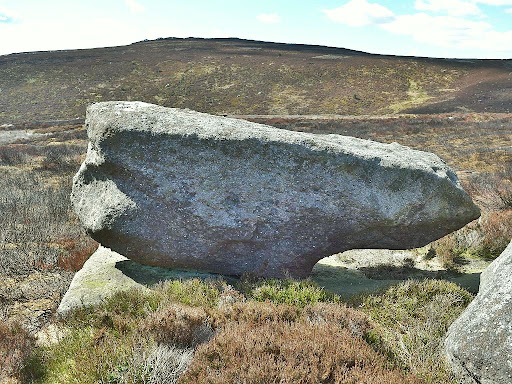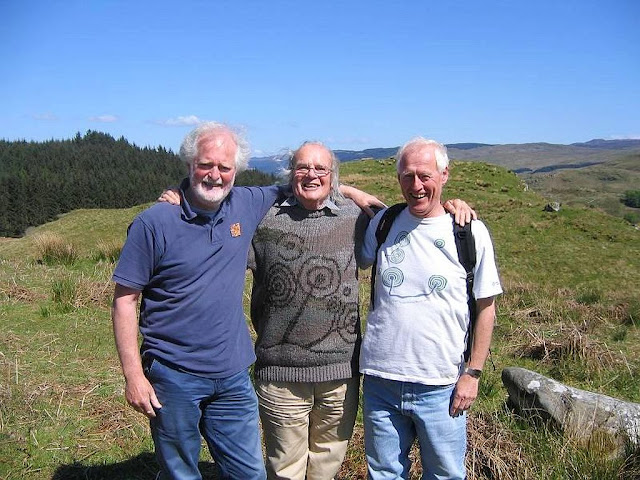
|
|
The Barden Fell Rocking Stone |
After the disappointment of finding the Thornthwaite rocking stone had been destroyed by Victorian quarrymen, a visit to Barden Fell also failed to identify the rocking stone marked there on the old OS map. A couple of large rocks at the location seemed likely candidates, but no amount of pushing and shoving could get either rock to move. On that occasion it was suspected that the rocking stone was the longer of the two rocks, and that it had been pushed off its pivot point. However, a return visit in October 2022 had more success, and identified the adjacent 3 metre long 'anvil' shaped boulder as the rocking stone (SE 08055 58520). Standing on top of this rock at its highest point, and using body weight, it was quite easy to set the boulder in motion. As with other rocking stones in this region the movement is not particularly dramatic - but this is still moving a rock weighing several tons. It is possible that pushing the 'nose' end of the rock may also set it moving, but this was not tried on that occasion.
The nearby seats and the track leading to the rocking stone - as shown
on the 1854 OS map, suggest that it was a locally known feature at that time,
and perhaps visited by people taking a tour from Bolton Abbey, up through the
"Valley of Desolation" and on to the Simon's Seat crags further to the north.
The bridle road track would allow access on horse back or by pony and trap.
Elsewhere in Britain, rocking stones are associated with legends of giants and witches, and some rocks were believed to have healing properties. If there were any such beliefs attached to the Barden Fell Rocking Stone then they have been lost, as the only reference to it seems to be on the OS map. There are a couple of round indentations on the north end of the rock which may be natural, or possibly the eroded remains of ancient cup marks. It is also worth noting that in the past people would scrape rock dust from 'special' stones and use it in folk medicine.
The rocking stones to be found in France have preserved more of their folklore, and here they are called Roche Tremblante -the trembling or shaking rock, and Pierre Branlante - the loose or wobbling stone. They are said to be gathering places for witches and fairies, and like Britain, there are legends of giants throwing or placing the rocking stones into their balanced position. Some rocking stones were used in a kind of divination where a question would be asked while trying to push the stone, and if the stone rocked the answer was yes, if it stayed immobile, then no. One rocking stone was said to have been a 'Judgement stone', where a person accused of a crime tried to rock the stone, and if they succeeded it proved their innocence. Some rocks were more specific, and sailors would visit La Roche Tremblante at Tregunc to check if theirs wives had been unfaithful while they were away at sea. If the stone rocked they would not be happy. A variation on this theme was a wife accused of being unfaithful could prove her innocence by making the stone rock. It is also said some 'canny' women visited the rocking stone before hand to make sure they knew the exact point on the rock to push and make it move.
Another piece of folklore has courting couples attempting to rock the
stone, and if they succeeded it was a sign that they would be married within
the year. (Worth noting that the narrow lane leading to the Thornthwaite
Rocking Stone was called 'My Love Lane'). There may have been an element of
bawdy euphemism to the tale of courting couples 'making the stone rock', and
this would perhaps explain why a marriage would follow soon afterwards. The
courting couples and the seemingly common link with women's sexual activity
begins to point to the rocking stones being part of the wider folklore
connecting certain rocks with fertility beliefs (see the
Arnecliff Wishing Stone). The later stories of unfaithful wives and witches visiting the rocking
stones may have been an attempt to dissuade women from visiting the stones for
fertility reasons.
Back on Barden Fell the cluster of rocks called Nanny
Crag can be seen on the moor to the west of the rocking stone - Nanny was a
common witch name in this region.

|
|
Looking south from the rocking stone |
Today the Barden Fell Rocking Stone sits quietly on the moor, 'watching' hikers heading up to Simon's Seat. It has perhaps been many years since someone last rocked the stone, but it 'rocked' in 2022, so the tradition lives on.
Keep on Rocking
All this talk of 'Rocking' prompts me to dedicate this post to
the memory of Jan Brouwer - the Dutch rock art enthusiast who passed away in
2011. In 2010, Jan and a group of fellow enthusiasts spent a pleasant
afternoon looking at the rock carvings on the Fylingdale Moors, not knowing
that would be the last time we would see Jan. Looking back, it was quite a
poignant moment when we parted, and Jan gave us all a thumbs up, along with
his catch phrase "keep on rocking".
I am sure Jan would have laughed to see some old guy stood on top of a boulder
on Barden Fell wiggling his hips trying to make the rock move, but he did say
to "Keep on Rockin".

|
|
Three Amigo's - Jan Brouwer (left), Stan Beckensall (centre) and Gus Van
Veen |


Post a Comment